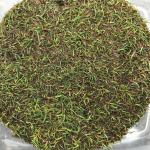Foliar anthracnose has been observed on putting greens in Massachusetts and Connecticut. Prolonged cool, wet weather this spring delayed shoot growth in many areas, making turf more susceptible to the disease. Anthracnose is considered a “stress disease”- it attacks turf growing under low fertility, temperature stress, drought, and other conditions that impair turf vigor. Anthracnose is typically seen on bluegrass but in recent years it has become more common on bentgrass.
Anthracnose is caused by the pathogen Colletotrichum cereale. This fungus survives in plant debris or infected turf tissues. C. cereale commonly causes a foliar blight, but may cause basal rot if the fungus infects the crowns and/or stolons. The disease is most severe in areas of poor drainage, heavy traffic, and soil compaction. Anthracnose is sometimes accompanied by its friends, Leptosphaerulina and Curvularia, which are also stress diseases. These diseases strike low-cut turf and are therefore not an issue on lawns.
Cultural management practices are critical both for prevention of anthracnose and for successful treatment of existing infections. Spring topdressing can be very effective if summer topdressing is minimal. Light topdressing throughout the summer has also been associated with an overall improvement in anthracnose control in mid to late summer. Use walk behind mowers if possible and raise the height of cut: an increase of as little as 0.02 inch can have a significant impact on disease severity. Green speed can be maintained by rolling. Irrigate greens as needed to avoid drought stress. If seeding new greens, consider bentgrass cultivars with moderate resistance to anthracnose (resistant cultivars that perform well in Massachusetts can be found at http://ag.umass.edu/turf/professional-turf-ipm-guide/turfgrass-selection-species-cultivars).
Nitrogen fertility can have an effect on anthracnose severity. Nitrogen application in spring is generally more effective than in fall for anthracnose control. Nitrogen applied at rates of 1-2lbs/1000 ft2 in early spring can help turf outgrow the disease. With higher rates, slow-release N should be included. Potassium nitrate is generally the most effective form for anthracnose management; avoid ammonium sulfate. In late spring and throughout the summer, nitrogen should be applied to greens biweekly at a rate of 0.1-0.2 lbs/1000ft2 to encourage the growth and spread of healthy turfgrass.
Several fungicides are available for anthracnose management on golf courses. Preventive spray programs are more effective than curative programs. Be sure to rotate FRAC groups to prevent resistance development.
Submitted by: Dr. Angela Madeiras
